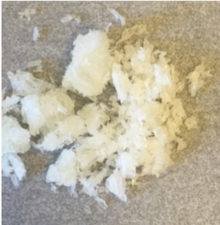Anisyl sulfanyl methyl isocyanide (Asmic)[2][3] is an organic molecule that contains an isocyanide group and an ortho-methoxy-phenyl sulfide group. Asmic can be used to synthesize tri-substituted isocyanides. Asmic is a colorless to off-white solid with a melting point of 27 °C[4] that can be prepared by dehydration of the corresponding formamide by POCl3.[5][6]
 | |
 | |
| Names | |
|---|---|
| Preferred IUPAC name
1-[(Isocyanomethyl)sulfanyl]-2-methoxybenzene | |
| Other names
Asmic; Anisyl sulfanyl methyl isocyanide
| |
| Identifiers | |
3D model (JSmol)
|
|
| ChemSpider | |
| ECHA InfoCard | 100.402.334 |
| EC Number |
|
PubChem CID
|
|
CompTox Dashboard (EPA)
|
|
| |
| |
| Properties | |
| C9H9NOS | |
| Molar mass | 179.24 g·mol−1 |
| Appearance | Off-white solid |
| Melting point | 27 °C (81 °F; 300 K) |
| Solubility in polar organic solvents | Soluble |
| Hazards | |
| GHS labelling:[1] | |
 
| |
| Warning | |
| H301, H311, H315, H319, H331, H335 | |
| P261, P262, P264, P264+P265, P270, P271, P280, P301+P316, P302+P352, P304+P340, P305+P351+P338, P316, P319, P321, P330, P332+P317, P337+P317, P361+P364, P362+P364, P403+P233, P405, P501 | |
Except where otherwise noted, data are given for materials in their standard state (at 25 °C [77 °F], 100 kPa).
| |
Asmic can be deprotonated at the position adjacent to the isocyanide by various organic bases. The anionic form of Asmic, which is stable at low temperatures, can be alkylated with a variety of electrophiles. Two sequential deprotonation-alkylation reactions and a subsequent sulfur-lithium exchange reaction allow the synthesis of tri-substituted isocyanides.[5]
The ortho-methoxy-phenyl sulfide group is thought to facilitate deprotonation by chelating to metalated bases allowing for the base to achieve optimal trajectory during the deprotonation.[5]
Asmic can be used to prepare oxazoles by condensation reactions with esters. The ortho-methoxy-phenyl sulfide group can also undergo sulfur-lithium exchange, and likely proceeds via a 10-s-3 sulfuranide.
References
edit- ^ "1-[(Isocyanomethyl)sulfanyl]-2-methoxybenzene". pubchem.ncbi.nlm.nih.gov.
- ^ Fleming, F. F. Composition, Synthesis, and Use of Isonitriles. U.S. Patent 8,269,032, Sept 18, 2012.
- ^ Zhu, Jieping; Tron, Gian Cesare; Novellino, Ettore; Massarotti, Alberto; Mercalli, Valentina; Basso, Andrea; Giustiniano, Mariateresa (2017-03-06). "To each his own: isonitriles for all flavors. Functionalized isocyanides as valuable tools in organic synthesis". Chemical Society Reviews. 46 (5): 1295–1357. doi:10.1039/C6CS00444J. ISSN 1460-4744. PMID 27983738.
- ^ Abstracts of Papers, 256th ACS National Meeting & Exposition, Boston, MA, United States, August 19-23, 2018 ASMIC-driven synthesis of vinyl isocyanide
- ^ a b c Alwedi, Embarek; Lujan-Montelongo, J. Armando; Pitta, Bhaskar R.; Chao, Allen; Cortés-Mejía, Rodrigo; del Campo, Jorge M.; Fleming, Fraser F. (2018-09-21). "Asmic: An Exceptional Building Block for Isocyanide Alkylations". Organic Letters. 20 (18): 5910–5913. doi:10.1021/acs.orglett.8b02574. PMC 6172042. PMID 30188137.
- ^ Shenvi, Ryan A.; Schnermann, Martin J. (2015-03-25). "Syntheses and biological studies of marine terpenoids derived from inorganic cyanide". Natural Product Reports. 32 (4): 543–577. doi:10.1039/C4NP00109E. PMC 4414506. PMID 25514696.